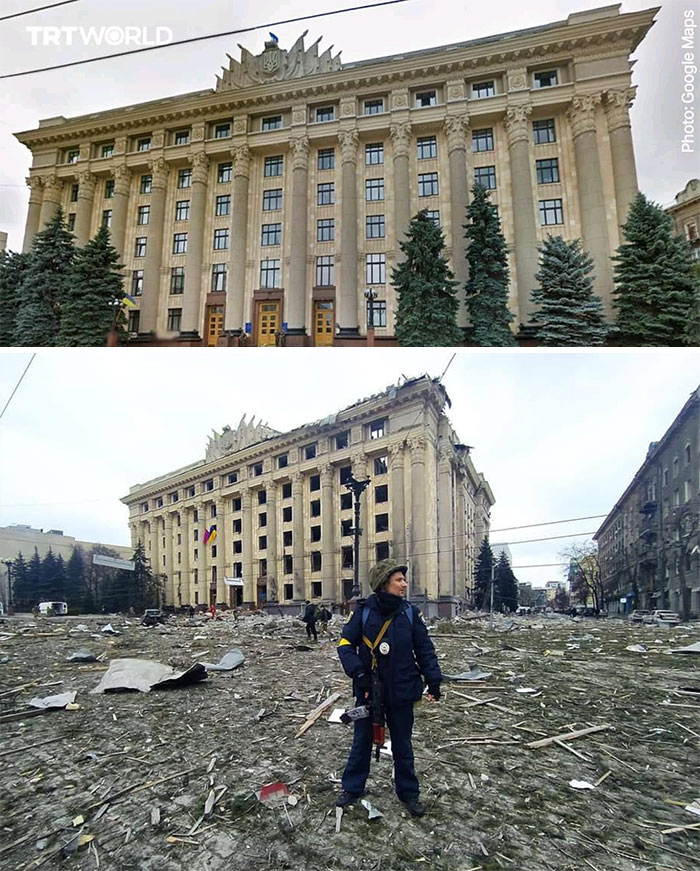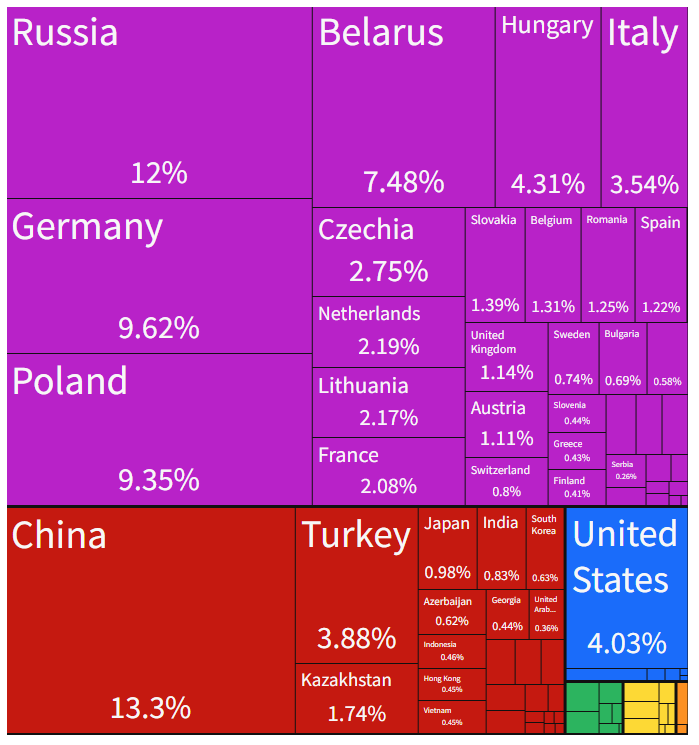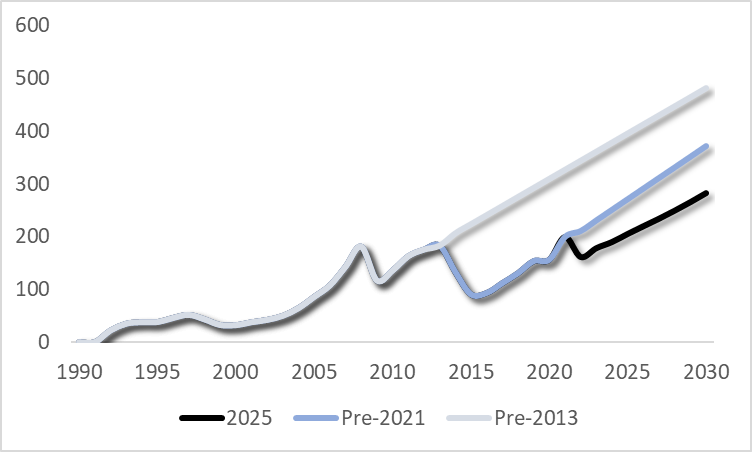As the endgame looms over the proxy war in Ukraine, the catastrophic costs of the unwarranted conflict continue to soar. There was an alternative future for Ukraine, based on development. But it was purposely denied.

Ukraine before and after the war.
Since the onset of hostilities in Ukraine three years ago, I have argued that, whatever its stated rationale, it would “penalize severely Ukraine, Russia, the U.S. and the NATO, Europe, developing economies and the global economy.”
The war in Ukraine was not only avoidable but there was an alternative and more peaceful future. It was purposely collapsed because it did not fit the neoconservatives’ plans for Ukraine.
Zelensky’s dream of Ukraine as China’s bridge to Europe
Even as Ukraine-Russian tensions began to escalate a decade ago, trade ties between Ukraine and China expanded after President Viktor Yanukovych’s state visit to Beijing in 2013. Four years later, Ukraine, now under President Poroshenko, joined China’s Belt and Road Initiative (BRI). And in 2019, China bypassed Russia as Ukraine’s biggest single trading partner.
Together, China, Ukraine’s new economic partner, and Russia, its historical trade partner, absorbed a fourth of Ukraine's exports. That figure was over six times the share of the U.S.

Ukraine’s major trading partners, 2021
Source: The Observatory of Economic Complexity, Mar 1, 2022
In June 2021, China and Ukraine signed a deal to strengthen cooperation in multiple areas, particularly in infrastructure financing and construction. In 2021, overall trade boomed to $19 billion, having soared 80% since 2013. To Ukraine’s President Zelensky, the BRI meant an alternative future that would be more stable and prosperous. And so, in a phone conversation with President Xi Jinping, he called China “Ukraine’s No. 1 trade and economic partner in the world,” expressing hope that Ukraine could become “a bridge to Europe for Chinese business.”
In just a year, major Chinese companies started operations in construction, food and telecoms. New contracts signed by Chinese companies in the Ukrainian engineering market exceeded $2 billion for two consecutive years.
But this was not the future that was planned for Ukraine in the White House.
Hammering Ukraine into a military-industrial hub
From 1991 to 2014, the U.S. flooded Ukraine with $4 billion in military assistance, even though it wasn’t a NATO member. By 2021, over $2.7 billion was added to the figure, plus over a billion provided by the NATO Trust Fund.
To Erik Prince, it heralded a great money-making opportunity, Iraq déjà vu. As the founder of the private U.S. military contractor, then known as Blackwater, Prince had long supplied mercenaries to the CIA, Pentagon and State Department for covert operations, including torture and assassinations. In early 2020, Prince outlined a roadmap for the creation of a “vertically integrated aviation defense consortium” that could bring $10 billion in revenues.
Prince desperately needed the Motor Sich factory, which already had a deal with Beijing Skyrizon Aviation. The Chinese company had bought its 41% stake already in 2017. However, Biden's election win undermined Prince’s plan. Moreover, his Ukrainian partners got under criminal investigation for alleged efforts to sway the 2020 presidential election and the investigation included President Biden’s son and his stakes in Ukraine. Washington blacklisted the Chinese firms involved, then the Ukrainian court froze their holdings for reasons of “national security” and Chinese companies and dealmakers were sanctioned.
Nonetheless, the idea of a Ukrainian military-industrial complex remained attractive to the U.S. and Ukraine, where the state-controlled defense sector employed more than 1 million people and had been moving, with rising U.S. influence, toward military procurement since 2014.
To the Biden administration, it offered a massive military-logistical hub that could serve both the U.S. and NATO.
Self-delusions of the true believers
In The Best and the Brightest (1972), David Halberstam noted that it was the refusal of the U.S. elite policymakers to recognize the true economic and human costs of Vietnam escalation that led them to sacrifice realism for wishful fantasies. As Secretary of State Dean Rusk said, “We will not pull out until the war is won.”
Similarly, in September 2022, Secretary of State Antony Blinken pledged lasting U.S. support for Ukraine during a visit to Kyiv, while the Biden administration helped Ukraine’s military recapture territory occupied by Russia. As he declared, “We will support the people of Ukraine for as long as it takes.” (A year later President Biden and Blinken would make similar pledges to Israel, which led to genocides in Gaza and regional devastation.) Yet, by late fall 2022, the status quo was changing. Even European Commission President Ursula von der Leyen acknowledged Ukraine’s losses in the war with Russia amounted to 100,000 soldiers and 20,000 civilians.

Fighting to the last Ukrainian
Zelenskyy ‘s carefully choreographed plea for more military aid in the Congress (source: Wikimedia). von der Leyen on Ukraine’s huge losses (source: Screenshot of von der Leyen tweet)
Today, three years later, the total cost of reconstruction and recovery in Ukraine is estimated at $524 billion over the next decade – almost three times Ukraine's GDP in 2024.
The military aid has brought neither peace nor security. But it has prolonged Ukrainians’ suffering. To date, the U.S. alone has provided $67 billion in military assistance since February 2022 and $70 billion in military assistance since 2014. These have been coupled with military assistance via the presidential emergency authority by up to $32 billion from Pentagon’s stockpiles.
That’s a total of $167 billion – in wasted lives, economic prospects and global prospects.
Economic and human costs of the avoidable war
After the end of the Cold War, the peaceful rise of Ukraine was the prevailing reality. But as the plans of development and welfare were replaced with those of geopolitics and warfare, Ukrainian GDP has suffered a drastic plunge (see black line in the below figure). Assuming incremental trends in the next half a decade, Ukrainian GDP is anticipated to reach $283 billion in 2030. But if the hostilities of 2022-25 had been avoided, this figure could have been $372 billion (light-blue line). And if all these hostilities since 2014 had been avoided and if Ukraine had been able to continue Zelensky’s infrastructure modernization with Chinese development, Ukraine’s GDP could have soared to $482 billion in 2030.

Ukrainian GDP, current prices, 1990-2030
Source: IMF, WEO Outlook Database
These missed opportunities reflect a catastrophic collapse of a future that Ukraine could have had, if it had been allowed to build on development and prosperity. Had that peaceful trajectory prevailed, Ukraine’s economy in 2030 would be 70% larger than what it is likely to be.
The demographic collapse is even worse. As the NATO expansion intensified in Eastern Europe and geopolitical tensions substituted for peaceful development, Ukraine’s population has declined from 51 million in 1990 to just 34 million people.
Ukraine has lost over 33% of its population since the end of the Cold War; and 9 million in just three years. Due to migration, the final toll is even worse. Since spring 2022, millions of Ukrainians have fled the country, with nearly 7 million Ukrainian refugees living abroad.
Since the onset of hostilities, total Ukrainian casualties amount to 400,000.
The demise of Ukraine
In spring 2022, the West promised Ukraine freedom and democracy, security and prosperity. Today, most freedoms have been compromised under the fog of war. Democratic institutions are overshadowed by external interests and domestic oligarchs. Many national assets have been mortgaged to Western interests for years to come.
Had Ukraine followed the development trajectory, its economy would not be the size of Algeria in 2030. It would be a half-trillion-dollar economy, like Iran or South Africa. Per capita income would be more than 40% higher than today. Economic opportunities might have reversed some of the migration flows back to Ukraine, which would have over 10 million more inhabitants than today.
The proxy war between the U.S.-led West and Russia in Ukraine has proved just as catastrophic as projected in 2022 and thereafter. It has contributed to secular stagnation in the U.S. and particularly in Europe where the misallocation of scarce allocations from welfare to rearmament is compounding a series of cost-of-living crises. Coming at the heel of the global pandemic, the consequent food and energy crises have severely aggravated the challenges of the Global South. And if the war is allowed to fester further, global economic prospects will be penalized even worse.
What happens in Ukraine will not stay in Ukraine. As long as aggressive geopolitics is favored at the expense of proactive international diplomacy, even promising futures can turn into dark wastelands.
